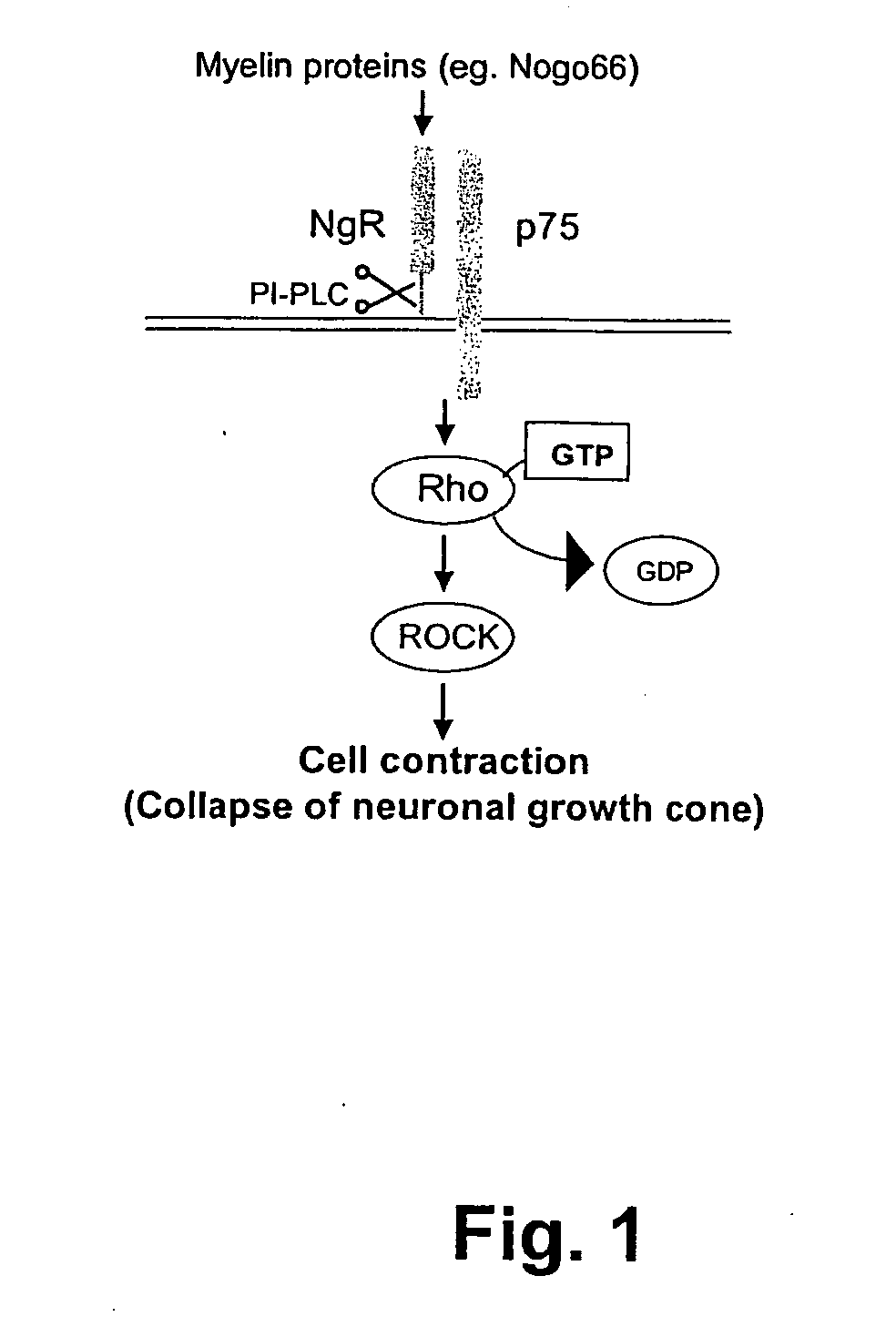Cellular RhoGTPase activation assay
a rhogtpase activation and assay technology, applied in the field of cellular rhogtpase activation assay, can solve the problems of low reproducibility, poor quantifiability, unsuitable high throughput assay, etc., and achieve the effect of stabl
- Summary
- Abstract
- Description
- Claims
- Application Information
AI Technical Summary
Benefits of technology
Problems solved by technology
Method used
Image
Examples
example 1
Preparation of AP-Nogo66:
a) Cloning of the Nogo66 fragment of hNogoA
[0156] The starting point was the published hNogoA sequence (NCBI): AF148537. The two following synthetic oligonucleotides were derived from the published sequence: [0157] Mez 402: GCCACCATGAGGATATACMGGGTGTGATCC (SEQ ID NO: 1); oligo from amino acid R1055 (italic) with start ATG (underlined) and Kozak sequence (bold) [0158] Mez 404: CTTCAGAGMTCMCTAAATCATC (SEQ ID NO: 2); oligo up to amino acid K1120 (bold)
[0159] A PCR was carried out with these two oligos in frontal cortex cDNA as template (prepared using Superscript first strand synthesis system for RT-PCR; Invitrogen, Carlsbad, Calif.) (Novak et al., Brain Res. Mol. Brain, 2002, 107(2): 183-189). The reaction was carried out by a standard method, like Innis et al. (PCR Protocols. A Guide to Methods and Applications, Academic Press (1990)) with Herculase (Stratagene, La Jolla, USA). The resulting DNA fragment with a size of 207 bp was purified using the QIAEX I...
example 2
Preparation of Constructs to Generate Recombinant HEK Cell Lines
a) Cloning of hp75; Preparation of pcDNA3.1(V5-His)hp75 No. 16 (FIG. 3d)
[0168] The starting point was the published sequences for human p75: NM—002507; M14764 (which are both 100% identical). The following oligonucleotides were derived from the published sequence:
Mey 36: GCCACCATGGGGGCAGGTGCCACC (SEQ ID NO: 4); oligo with start codon (bold) with Kozak sequence (italic)
Mey 35: TCACACTGGGGATGTGGCAG (SEQ ID NO: 3); oligo with stop codon (bold) in a base exchange of T instead of C (underlined) because the oligo is derived from the published rat sequence
Mey 71: GCAGCCCCATCAGTCCGC (SEQ ID NO: 5); oligo starting 64 base pairs in front of ATG
[0169] A PCR was then carried out (in analogy to the Nogo 66 cloning, example 1) with the primer pair Mey 35 / 71 in cDNA from the cell line SH-SY5Y (human neuroblastoma cell line ATCC #CRL-2266). The PCR with Mey 35 / 71 afforded a 1348 bp fragment. This was purified.
[0170] A subseq...
example 3
Generation of Stable Recombinant HEK Cell Lines
a) Preparation of the Double Transfectant HEK293 NgR / p75
[0188] HEK293 wild-type cells (cultured in RPMI Glutamax+10% dial. FCS+1% antibiotic-antimycotic) were transfected in a first transfection step with the plasmid pIRES hNgR hp75. For this purpose for each mixture, 2 μg of plasmid DNA were mixed in 100 μl of serum-free RPMI-Gutamax medium and 2×106 cells in 12 μl of LIPOFECTAMINE in 100 μl of serum-free RPMI-Gutamax medium in culture dishes with 10 wells, and incubated at room temperature for 15 to 20 minutes. The total volume was then made up to 1 ml for each transfection mixture using serum-free medium. Subsequently, 2 ml of serum-free RPMI-Gutamax medium were added to each dish, and incubation was carried out at 37° C. for 6 h. The medium was then changed to RPMI-Glutamax+5% dialyzed FCS and incubation was carried out at 37° C. for 1 day. The contents of the dishes were then split (in various dilutions: 1:10; 1:50, 1:100, 1:250...
PUM
 Login to View More
Login to View More Abstract
Description
Claims
Application Information
 Login to View More
Login to View More - R&D
- Intellectual Property
- Life Sciences
- Materials
- Tech Scout
- Unparalleled Data Quality
- Higher Quality Content
- 60% Fewer Hallucinations
Browse by: Latest US Patents, China's latest patents, Technical Efficacy Thesaurus, Application Domain, Technology Topic, Popular Technical Reports.
© 2025 PatSnap. All rights reserved.Legal|Privacy policy|Modern Slavery Act Transparency Statement|Sitemap|About US| Contact US: help@patsnap.com



